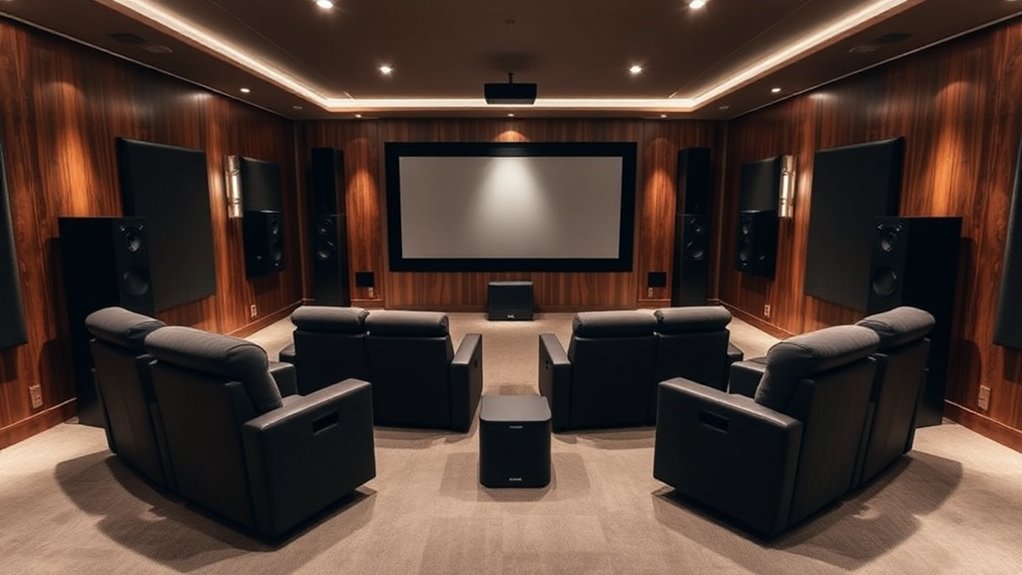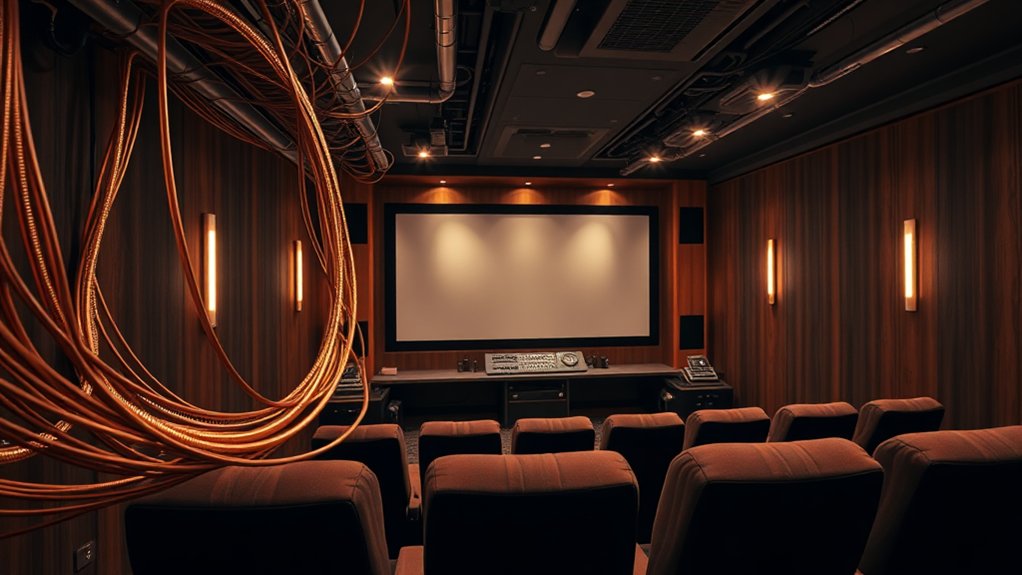To arrange comfy home theater seating, start by determining your ideal viewing distance—generally, aim for around 9 feet from a 55-inch TV. Next, measure your space, allowing at least 20 inches between chairs for comfy movement. Verify rows have 20 inches of space for easy access, and consider ergonomic seating with features like lumbar support and cup holders (because who doesn’t love snacks?). If you’re curious about lighting options and layout strategies, just keep investigating for more insights!
Key Highlights
- Measure your room dimensions and factor in around 20 inches for clearance on each side of the seating arrangement.
- Calculate optimal seating distance based on screen size, aiming for a distance that enhances viewing comfort and minimizes eye strain.
- Prioritize ergonomic seating with lumbar support and extra features like cup holders to enhance comfort for long viewing sessions.
- Create pathways between seats to facilitate navigation and maintain a social atmosphere while ensuring at least 20 inches spacing between rows.
- Consider tiered seating to provide unobstructed views of the screen, allowing for a more authentic and comfortable movie-watching experience.
Understanding the Ideal Viewing Distance
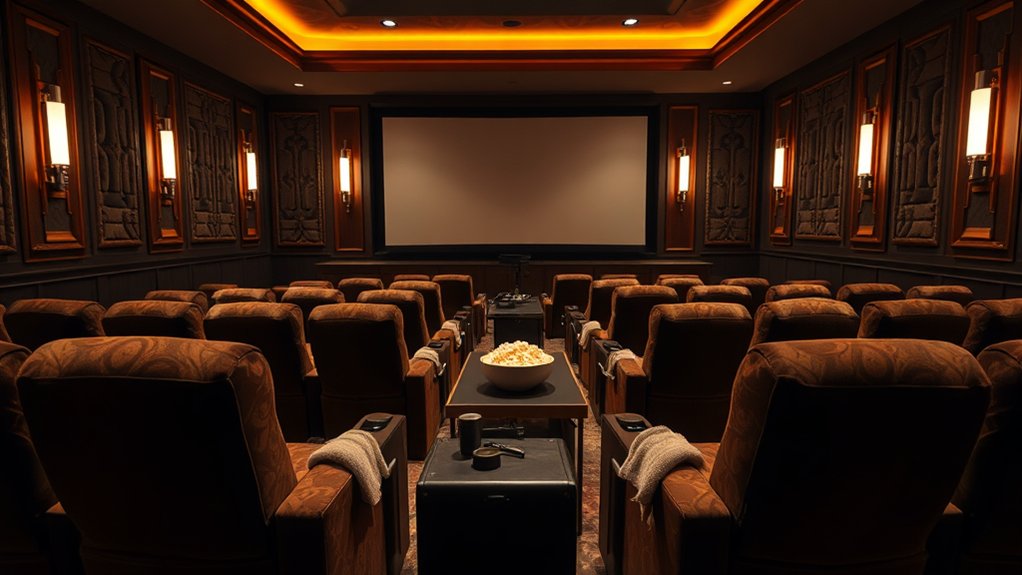
When setting up your home theater, understanding the ideal viewing distance is key to creating an enjoyable viewing experience, and there are some essential guidelines to follow.
For a 55-inch TV, you’ll want to sit about 9 feet away, but that can change depending on your screen’s resolution. Full HD is best viewed within 5 feet, whereas a 4K TV lets you scooch in closer at just 3 feet away. Remember, higher resolution means you can enjoy those pixel-perfect images without squinting! A good rule of thumb is to multiply your screen size in inches by 0.84 to find your best viewing distance. Additionally, maintaining an optimal horizontal viewing angle helps ensure that multiple viewers can enjoy the show comfortably. A safe viewing distance is essential for eye health, reducing strain and enhancing your overall viewing experience.
Determining Seat Quantity for Your Space
After you’ve nailed down the ideal viewing distance for your home theater, the next logical step is figuring out how many seats you can comfortably fit into the space.
Start by measuring your room’s dimensions, remembering to account for clearance—around 20 inches on each side for easy access.
To maximize comfort, always measure your room and include 20 inches for clearance on each side.
Now, let’s do some math: dividing your usable width by the average chair width (about 22 inches) helps determine how many seats can line up per row. It’s crucial to ensure that your minimum room size accommodates both seating and home theater equipment effectively. Additionally, consider that viewing angles should be between 36 and 50 degrees to ensure optimal sight lines for all seats.
Don’t forget to factor in armrests and any architectural quirks that may squeeze your seating options.
In the end, aim for a balance of quality over quantity. After all, who wants to squish into a tight spot when you could lounge comfortably instead?
Ensuring Proper Row Width and Spacing
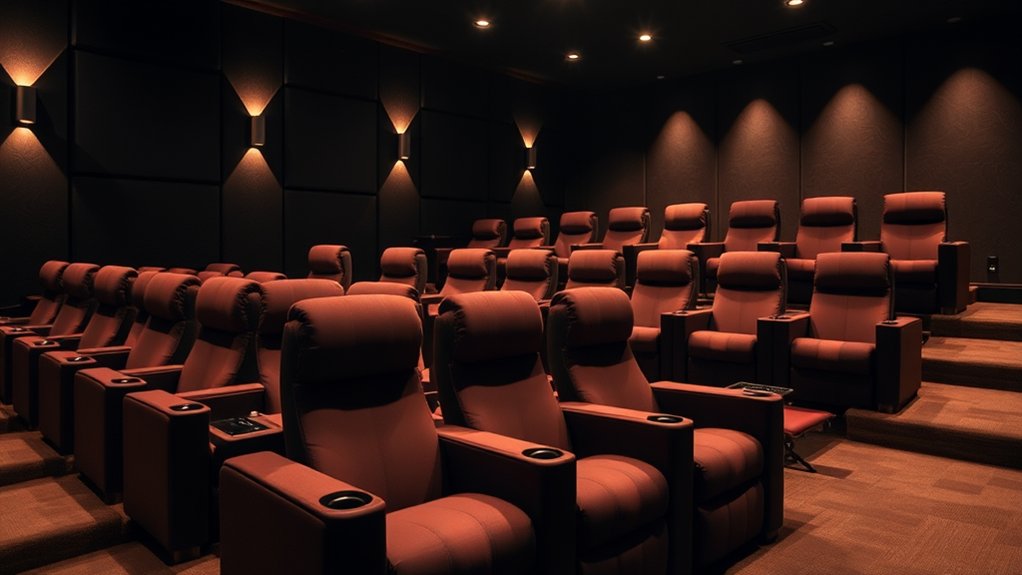
To guarantee your home theater setup isn’t just a crowded assembly of seats, it’s essential to nail down the right row width and spacing. Start by considering that home theater seats typically range from 20 to 26 inches wide, and you’ll need to account for armrests, which can add another 5 to 8 inches.
So, subtract at least 40 inches from your room’s total width for comfortable side clearance, then divide by your seat width for the number of seats. When spacing rows, aim for a minimum of 20 inches between them to allow easy entry. If you’ve got recliners, don’t forget to add extra depth for leg rests. After all, tight spaces aren’t just uncomfortable; they’re downright awkward, aren’t they? To enhance comfort, consider the optimal seating arrangements with intentional spacing for a more enjoyable viewing experience.
Enhancing Accessibility and Movement
Creating a home theater that’s both enjoyable and accessible isn’t just about placing a bunch of seats in a room; it’s about ensuring everyone can navigate the space with ease and comfort.
To achieve this, you’ll want to disperse wheelchair spaces throughout, ensuring great sight lines and easy access during emergencies. Pairing wheelchair spots with companion seats creates a welcoming atmosphere, as clear signage and sufficient aisle width improve navigation.
Don’t forget about the flooring—slip-resistant options and minimal thresholds help everyone move safely.
Finally, think about medical needs, ensuring extra space for devices, and plan for flexibility in seating arrangements. After all, who wants to be stuck in a jam during that gripping movie climax?
Selecting Comfortable Seating Features
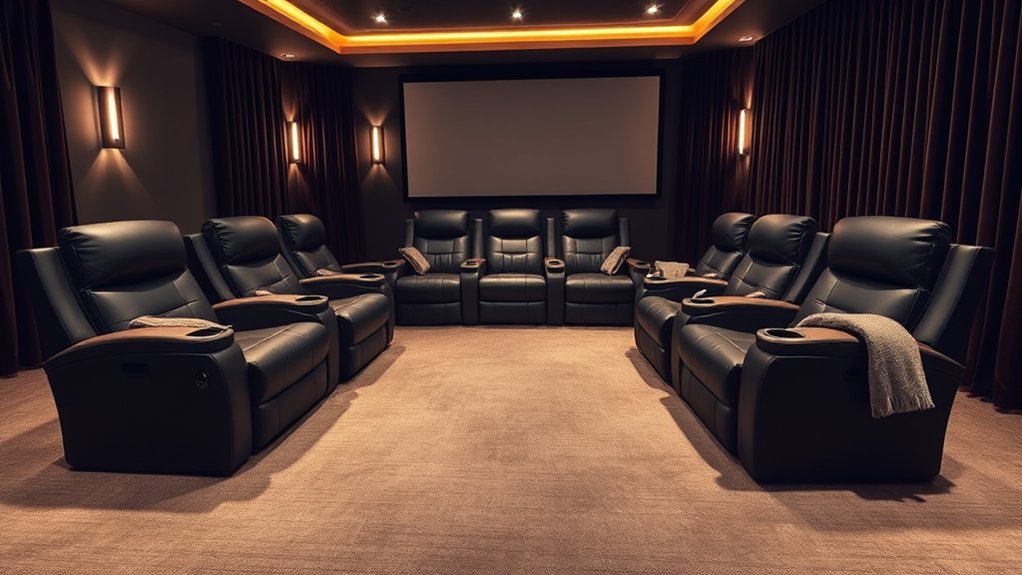
Even though you might think all chairs are created equal, selecting comfortable seating features for your home theater can make a world of difference in your movie experience.
First, look for ergonomic designs with ideal lumbar support to keep your back happy, particularly during those long marathons.
Adjustability is key—consider headrests and footrests that conform to your body’s needs, promising comfort without unnatural strain.
Then, investigate high-quality foam padding, like memory foam that offers both softness and resilience—because let’s face it, too much squish can sometimes lead to discomfort.
Finally, don’t overlook functional add-ons like wide armrests and built-in cup holders; they’re like icing on your cinematic cake, ensuring you can relax fully amid enjoying your favorite flicks.
Optimizing Audio Experience With Seat Placement
Regarding optimizing your audio experience through seat placement, getting the arrangement just right can turn your home theater into a sound haven.
Start by positioning your seats a few feet away from walls; this prevents bass amplification and boomy sound that can happen when you’re too close to hard surfaces. Align your seating centrally with the main speakers—think of that sweet spot where sound blooms, enveloping you in rich audio.
If you’ve got multiple rows, stagger the seating for better sound access. Elevating seats can likewise help; an unobstructed path from speakers to ears guarantees clarity. Additionally, consider using a high-performance soundbar like the Bowers & Wilkins Panorama 3 to enhance the immersive audio experience in your home theater.
Exploring Room Layout Options
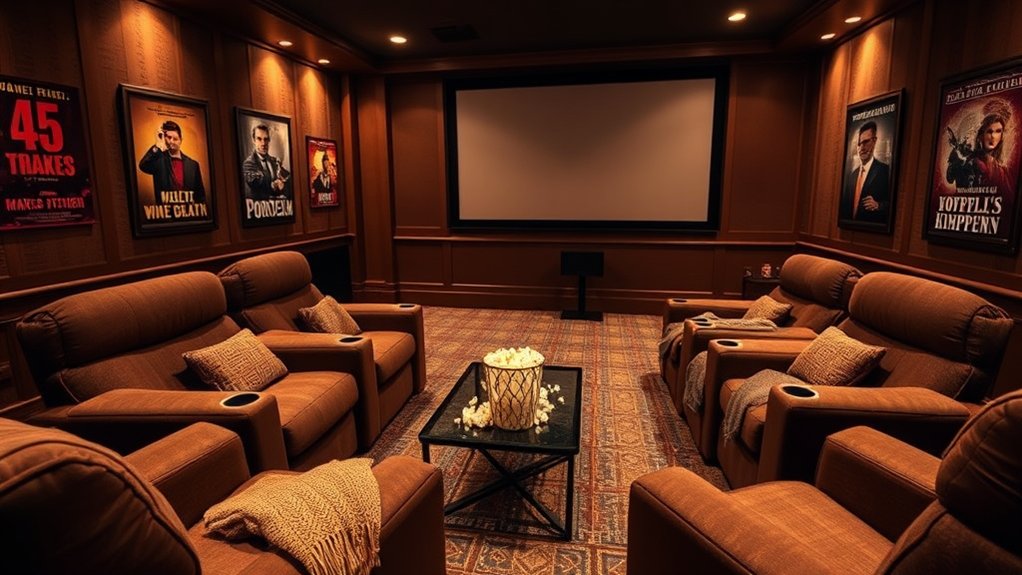
Regarding arranging your home theater, the layout can make all the difference in creating a comfortable and enjoyable viewing experience.
First, measure your space accurately—knowing the dimensions is key. For instance, you’ll want about three feet for each reclining chair, plus at least 3 feet 6 inches between rows for comfortable legroom (because who likes cramped legs?).
Accurate space measurements are essential for a comfortable home theater layout—allow three feet per chair and 3.6 feet between rows for legroom.
If your room’s small, a single row works wonders, with options for a straight or curved layout enhancing those all-important viewing angles.
On the flip side, if you’ve got room to spare, a two-row setup allows for greater capacity while ensuring adequate spacing, preventing a game of “who’s blocking who” during your movie marathon. Additionally, consider integrating a top-rated soundbar system that enhances audio quality to enrich your overall viewing experience.
Considering Aesthetic Elements in Seating Arrangement
When you plunge into arranging your home theater seating, considering the aesthetic elements is just as crucial as the functional layout itself.
Begin with colors that harmonize with your décor; neutral and dark tones are great for an immersive vibe without distractions. You might opt for plush fabrics—think leather or velvet—that not only increase comfort but also improve visual appeal.
Don’t forget pattern choices—subtle is key to maintaining balance. Additionally, mix textures for interest, creating that cozy yet stylish atmosphere.
You’ll want to avoid rigid rows; integrating curves gives the space a more inviting feel. Remember, it’s about creating a unified look, so coordinate your seating with other elements for an engaging, cohesive design.
Accounting for Lighting and Environment Control
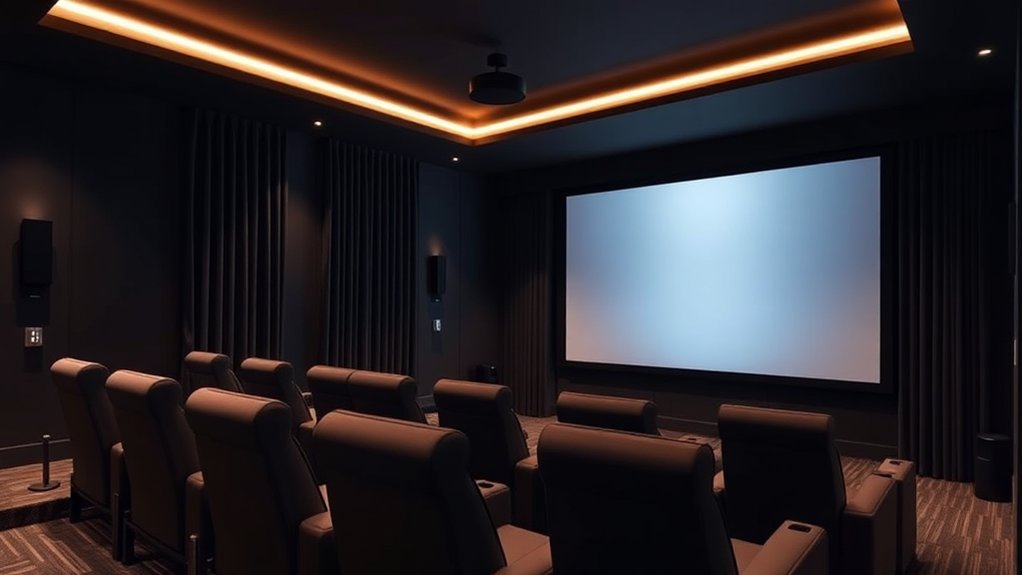
Creating the perfect ambiance in your home theater goes far beyond just picking the right seating arrangement; effective lighting and environmental control are essential to making your movie nights truly enjoyable.
Start by ensuring you maintain about four feet between rows for safe walkway lighting, as you map out paths for easy navigation. Incorporate dimmable overhead lights to prevent glare, and consider ambient wall sconces for a cozy vibe.
Under-seat or seat-side lighting can help individuals find snacks without disturbing others—because who wants to spill popcorn? Smart lighting controls let you customize scenes, ensuring a seamless movie experience.
And don’t forget those blackout curtains! They keep natural light at bay, making your theater feel like the ultimate cinematic escape.
Implementing Tiered Seating for Better Sightlines
Though you might think setting up seating in your home theater is as simple as putting chairs in a line, incorporating tiered seating can make all the difference for an enjoyable experience. Elevating your seating arrangement not only replicates that authentic movie theater vibe but additionally guarantees everyone has an unobstructed view of the screen—no more craning your neck or straining to see!
Proper riser height, typically around 7¾ to 14½ inches, keeps sightlines clear and comfy, whereas boosting sound quality by improving audio distribution. Plus, you’ll appreciate the improved room flow and visual aesthetics as tiered seating contributes to a well-balanced setup.
Frequently Asked Questions
What Is the Best Seat Color for a Home Theater?
When choosing the best seat color for your home theater, opt for dark hues like navy or deep brown. They absorb light, reduce glare, and create a cozy atmosphere, enhancing your overall viewing experience.
How Can I Enhance Ventilation Around Theater Seats?
To improve ventilation around theater seats, position exhaust vents strategically, incorporate quiet duct fans, and guarantee unobstructed airflow. Remember to separate heat sources from seating and use smart technology for best climate control.
Do Cup Holders Affect Seat Comfort in Home Theaters?
Cup holders greatly impact your comfort in home theaters by keeping drinks close and minimizing spills. They additionally improve relaxation, allowing you to enjoy movies without distractions, freeing your hands for snacks or remotes.
What Type of Fabric Is Best for Theater Seating?
When choosing fabric for theater seating, you’ll want materials like durable microfiber for easy maintenance, plush velour for comfort, or high-quality leather for a luxurious feel. Consider your household’s needs and aesthetic preferences too.
How Can I Create a Cozy Atmosphere in My Home Theater?
To create a cozy atmosphere in your home theater, you’ll want to use soft lighting, rich fabrics, and plush seating. Add throw pillows and blankets for extra comfort, as you keep the space warm and inviting.


